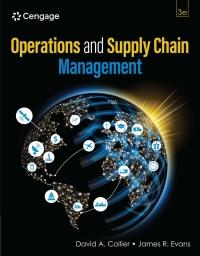A rare book library at a University of England in England houses first edition (FE), original manuscript
Question:
A rare book library at a University of England in England houses first edition (FE), original manuscript (OM), and authors’ journals (AJ). Some of these rare books are worth hundreds of thousands of dollars, and most are worth more than \($5,000.\) People from all over the world visit the library to use its unique collection of rare books, and they seldom if ever are allowed to remove books from the library. Only certified librarians are able to collect the requested books and manuscripts from the bookshelves, as many of them are very fragile. The rare book process involves the creation of value by the speed and reliability of the process (time utility); the safekeeping of human knowledge (place and information utility); the preservation of old books (form utility); and, to some rare book experts, the joy of seeing and reading the thoughts of people from different ages (entertainment utility). The output or outcome of the process is intangible—no physical goods are created here—just information, entertainment, historical research, and knowledge transfer. The goal of the librarian is to design a structured process with many checks and balances to ensure the security of the rare books, yet create professional service encounters. The process flowchart for examining rare books in a library is shown in Exhibit 11.34. Note the line of visibility that separates the front-office activities from the backoffice activities. Here, library patrons must follow a very small number of predefined pathways through the service delivery system. Customers have little freedom or power to depart from the standard pathways and service encounter activity sequences; the process is highly repeatable; and management control is high. Assume the throughput rate defined by Exhibit 11.34 is 40 library patrons per hour. All library patrons must remain in the visitor’s area until they register with one of the head librarians. On average, there are 10 people waiting in the visitor’s area. The head librarians verify that the patron has accounts in good standing with the library; this activity averages three minutes. After registering, the patron moves to a reference waiting area. On average, 12 people are waiting to be serviced in this second waiting area. A special librarian then takes the request from the patron and guides him or her to one of three smaller waiting areas in the library: first editions, manuscripts, and authors’ journals. This first special librarian activity averages 4 minutes and is the first of two activities carried out by the special librarian. One special librarian handles one customer at a time. On average, 50 percent of the patrons ask to see first editions, 40 percent ask for original manuscripts, and 10 percent ask for authors’ journals. When patrons arrive at one of the three smaller waiting areas, they wait for the special librarian to perform the second activity, which is finding and retrieving the item. The library staff estimates, on average, that five people are waiting to be served for first-edition books, three people waiting to be served for an original manuscript, and one person is waiting to be served for an authors’ journal. The special librarians take an average of four minutes to fill a firstedition book retrieval, and six minutes to fill an original manuscript or author’s journal retrieval. Worksheet Exhibit 11.35 may be helpful in answering questions about the process.


Case Questions for Discussion:
1.How many minutes, on average, does it take for a first-edition patron to get the requested book from time of entry into the library? (State all assumptions and show the calculations.)
2.How many minutes, on average, does it take for the average library patron to get the requested book from time of entry into the library? (State all assumptions and show the calculations.)
3.How many patrons, on average, are there in the total library service delivery system? (State all assumptions and show the calculations.)
4.If the following numbers of employees work at each activity, what is labor utilization for each job activity? Head librarian: two employees, three minutes per activity; special librarian check-in: three employees, four minutes per activity; first-edition retrieval: two employees, four minutes per activity; original manuscript retrieval: two employees, six minutes per activity; and authors’ journal retrieval: one employee, six minutes per activity.
5.What labor resource is the bottleneck?
6.What do you recommend to break the bottleneck(s)? Explain and justify your reasoning.
Step by Step Answer:

Operations And Supply Chain Management
ISBN: 9780357901649
3rd Edition
Authors: David A. Collier; James Evans





